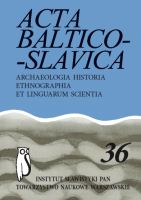Polszczyzna na Mohylewszczyźnie – przeszłość i stan obecny (raport z badań terenowych)
Polish language in the Mohylew region – the past and present (the report on field research)
Author(s): Małgorzata Ostrówka, Ewa GolachowskaSubject(s): Language and Literature Studies
Published by: Instytut Slawistyki Polskiej Akademii Nauk
Keywords: Belarus; the Mohylew region; Catholic Church; the Polish language
Summary/Abstract: The research in the Mohylew region is a continuation of research concerning the language of Catholics in former North-Eastern Borderland. The work contains an outline of the history of the Mohylew region including the history of the Catholic Church, education and functioning of Polish in this land. Besides Mohylew the following places were visited: Czausy, Faszczówka and Bez¬czynne where parishes are being revived. Evangelisation is in Belorussian and only in Mohylew one Holy Mass is in Polish every day. Conclusions: The Polish language in the Mohylew region has been functioning since 16th century what is confirmed in Mohylew town chronicles grave inscriptions in local Polish Cemetary. It has also been, excluding Jesuit parishes (Jesuits evangelised in the language of a given nationality, wrote catechisms and grammars) the language of prayers and lithurgy. The result of the progress of russification was that the range of its use nar¬rowed down. The next stage (20’s and 30’s of 20th century) of the fight with the Church and religion led to interrupting passing the Polish language even in those families where it survived throughout former stages. In this way the Polish tradition was interrupted. At present it is very difficult to meet people using the old local Polish language. The Polish with regional features can be heard with those people who came to Mo¬hylew after the World war II. There is also another quality: the language learned at school or courses. The Polish language is generally idiolectally diverse, its shape de¬pends on the degree of fluency in Polish. On the basis of reviving catholicism and the Polish language with numerous young people who discovered their roots there is a process of reconstructing the Polish identity.
Journal: Acta Baltico Slavica
- Issue Year: 2012
- Issue No: 36
- Page Range: 113-137
- Page Count: 25
- Language: Polish

